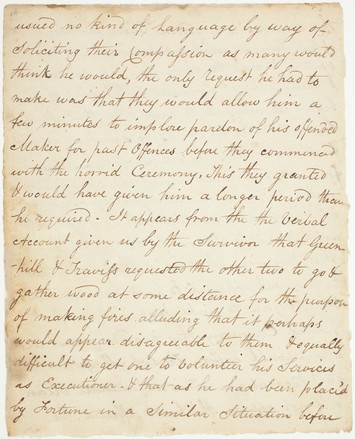The escapees’ plan was to reach Hobart, steal a schooner and sail to England. Their provisions however were hopelessly inadequate for such a journey, and were exhausted after only 15 days. The men then drew straws to determine who would be killed and eaten. Thomas Bodenham was the first victim of this horrific plan, and, according to Pearce, accepted his fate with remarkable calmness. After he was killed by an axe blow to the head, his body was butchered, roasted and ‘devoured greedily’.
Sustained by their meal, the convicts again set out, but found a direct route through the dense forest impossible. They stumbled over rotting logs, which often collapsed under their weight, tripped over coiling vines and fought their way through dense nets of ferns.
Dalton, Kennerly and Brown took fright when Bodenham was killed and decamped. Kennerly and Brown reached Macquarie Harbour, but Brown apparently died of exhaustion. That left Greenhill, Travers, John Mather and Alexander Pearce. With Greenhill and Travers acting as a team, it would be Mather's or Pearce's turn next. Pearce seems to have sided with Greenhill and Travers at this point, and Mather was the next victim. It was then that Pearce had some luck: Travers was bitten on the foot by a snake. Greenhill insisted they carry him for five days, but when it became clear he would not recover, killed him, leaving Pearce and Greenhill. Both men fought off the urge to sleep, eyeing each other uneasily. When Greenhill finally dozed off, Pearce seized the axe and ‘gave him a severe blow on the head which deprived him of life’. Taking part of Greenhill’s arm and thigh, Pearce struggled on for several days until reaching the bank of the Derwent River, where he joined a gang of bushrangers.
When he was finally captured on the outskirts of Hobart, the authorities refused to believe his horrific tale of cannibalism. There were no bodies to support his claim and they were sure he was protecting his companions, who they believed to be still at large. Pearce was shipped back to Macquarie Harbour. A year later, he escaped again, this time with one other convict, Thomas Cox. He was apprehended after a week, camped alone on a remote beach. In his pocket was a chunk of human flesh. This time he was believed, promptly tried and hanged in Hobart on 19 July 1824.
A similar, shorter version of Pearce’s account is held by the National Library of Australia at MS 3323. Other contemporary sources for Pearce's escape are:
1. Deposition made before Lieutenant Cuthbertson headed 'Pearces's Narrative' and catalogued in the Mitchell Library as 'Confession of Murder and Cannibalism', (ML A 1326). This appears to be the basis of the deposition placed before the Select Committee on Transportation 1837-38 (Molesworth Report').
2. Pearce's Confession to Rev Philip Conolly in the Hobart Town Gazette, 6 August 1824.
3. Pearce's Confession to the Keeper of the Hobart Town Gaol, 20 June 1824. Reproduced in Alexander Pearce of Macquarie Harbour by Dan Sprod, 1977.



 Back to list
Back to list